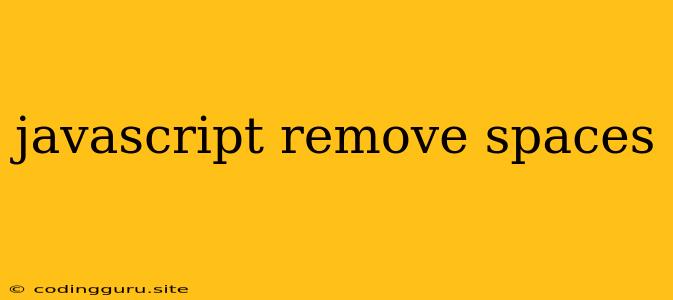How to Remove Spaces in JavaScript
Spaces can be a nuisance in many JavaScript applications, especially when dealing with strings. They can disrupt intended formatting, hinder data processing, or cause unexpected errors. Thankfully, JavaScript provides various methods to effectively remove spaces from strings, allowing you to clean up your data and streamline your code. This guide will explore different techniques and their applications to equip you with the tools needed to confidently handle spaces in your JavaScript projects.
Understanding the Problem
Before diving into solutions, let's first understand the problem: what exactly are "spaces" in JavaScript? In JavaScript, spaces are considered whitespace characters, including:
- Space (ASCII 32) - the most common type of space.
- Tab (ASCII 9) - often used for indentation.
- Line feed (ASCII 10) - marks the end of a line.
- Carriage return (ASCII 13) - used for moving the cursor to the beginning of a line.
- Non-breaking space (ASCII 160) - a special space that prevents line breaks.
Methods to Remove Spaces
1. String.replace()
The replace() method offers a versatile solution for removing spaces. It replaces all occurrences of a specified substring with another substring. To remove spaces, you can use the following pattern:
const myString = " This string has spaces. ";
const newString = myString.replace(/\s/g, '');
console.log(newString); // Output: "Thisstringhasspaces."
Explanation:
/\s/gis a regular expression that matches all whitespace characters (\s) globally (g).- We replace each match with an empty string (
''), effectively removing them.
2. String.trim()
The trim() method specifically removes leading and trailing spaces from a string. This is useful for cleaning up input values or removing unnecessary whitespace around text.
const myString = " This string has spaces. ";
const newString = myString.trim();
console.log(newString); // Output: "This string has spaces."
3. String split() and join()
This method provides a more granular approach. It splits the string into an array, removes spaces, and then joins the elements back into a string.
const myString = " This string has spaces. ";
const newString = myString.split(' ').join('');
console.log(newString); // Output: "Thisstringhasspaces."
Explanation:
myString.split(' ')splits the string into an array based on spaces.join('')joins the array elements back into a string, omitting any spaces.
Choosing the Right Method
The best method depends on your specific need:
replace()is powerful for removing all whitespace characters, including tabs and line breaks.trim()is efficient for removing leading and trailing spaces.split()andjoin()offer more control and flexibility, allowing you to manipulate individual elements within the string.
Practical Examples
1. Normalizing User Input:
const userInput = " Enter your name: ";
const normalizedInput = userInput.trim();
console.log(normalizedInput); // Output: "Enter your name:"
2. Creating a URL Slug:
const title = " This is a blog post title ";
const slug = title.toLowerCase().replace(/\s/g, '-');
console.log(slug); // Output: "this-is-a-blog-post-title"
3. Formatting Data for JSON:
const data = {
name: " John Doe ",
age: " 30 "
};
const formattedData = JSON.stringify({
name: data.name.trim(),
age: parseInt(data.age.trim())
});
console.log(formattedData); // Output: {"name":"John Doe","age":30}
Conclusion
Removing spaces from JavaScript strings is a common task that can be handled efficiently using various methods. By understanding the different techniques available, you can choose the most appropriate solution for your specific use case and write cleaner, more robust JavaScript code. Remember to carefully select the method based on your requirements, ensuring that you're addressing the specific type of whitespace removal needed.
